Contents

Proper nutrition is of great importance for the prevention and treatment of inflammation of the stomach. The diet reduces the severity of painful manifestations and increases the effectiveness of therapeutic manipulations.
An imbalance of food components (proteins, fats, carbohydrates, fiber) changes the pH of the stomach environment, stimulates the pathogenesis of gastritis, up to a stomach ulcer. All diets for chronic diseases of the stomach are developed taking into account the acidity of the gastric environment.
Based on nutritional value, treatment tables for gastritis are divided into two types:
Basic diets. The diet contains a sufficient amount of energy necessary to maintain the life of the patient, and at the same time has a beneficial effect on the walls of the stomach;
low calorie diets. With an exacerbation of pathogenesis (acute digestive disorders – constipation, diarrhea), a diet with a reduced energy value is used for several days.
Diets (tables) used to feed patients with gastritis have digital designations. Fifteen basic numbered therapeutic diets have been approved by official medicine. Some tables can be in several variations, denoted by letters of the alphabet. For diseases of the stomach, tables No. 1, 1a, 1b, 2, 3 and 4 are recommended. During the period of therapeutic nutrition for gastritis, alcohol and smoking should be avoided, as well as fatty, smoked, pickled, spicy and sour foods.
The nutrition of patients diagnosed with gastritis is based on several principles underlying such diets:
Exclude from the diet hot (above 600C) and cold (below 150C) meals
Choose the optimal temperature for diet food (20-500FROM);
Use the rules of eating: fragmentation (up to 5-6 times a day) and regularity (at the same time);
With hyperacid gastritis – exclude from the diet foods that stimulate the production of hydrochloric acid and irritate the walls of the stomach;
With hypoacid and anacid gastritis – give preference to products that accelerate digestion;
If a person has two diseases at the same time, for example, gastritis and diabetes, foods that are harmful to diabetes should also be excluded from the diet.
What can you eat with gastritis with high acidity?

The diagnosis of “chronic gastritis with high acidity” or “chronic hyperacid gastritis” is confirmed by comprehensive medical studies using laboratory and functional diagnostic methods.
The disease is characterized by an increase in the amount of hydrochloric acid produced, digestive enzymes and other components of gastric juice. Acid irritates the walls of the stomach, reduces their functional properties and changes the course of the physiological processes of digestion.
The main symptoms of gastritis with high acidity are pain between meals, heartburn after eating.
With gastritis with high acidity, it is forbidden to eat dishes based on rich mushroom, meat and fish broths, as well as convenience foods. They strongly irritate taste buds and stimulate additional production of hydrochloric acid.
The set of dishes that should consist of the diet of a patient with a diagnosis of gastritis with high acidity includes:
First courses (mashed soups on vegetables and cereals, soups with vermicelli cooked in water or milk);
Second courses (meat, fish, chopped into pieces, steamed, boiled or baked, sometimes lightly fried, without a crust);
Side dishes (boiled vegetables, pasta, soft cereals);
Salads, snacks (salads from boiled vegetables, snacks based on lean meats, fish, dairy sausages, cheese);
Milk 2,5% pasteurized, some fermented milk products (cream, yogurt, cottage cheese);
Fruits and berries of sweet varieties;
Drinks (tea, compotes from dried fruits, kissels, juices from some types of fruits, decoctions);
Bakery products (dried wheat bread, dry biscuits);
Fats (vegetable oils, butter).
In more detail about each ingredient in the menu of a patient with hyperacid gastritis:
Beef. It is recommended to use meat of the first category with a limited fat content. The energy value of this product is about 218 kcal per 100 g. The ratio of proteins and fats is 1:1. There are a lot of macro- and microelements in beef, especially phosphorus, sulfur, iron, zinc, copper, chromium, cobalt and molybdenum, as well as a high content of B vitamins. Chopped steam cutlets, portioned pieces of boiled, stewed, baked meat are prepared from beef;
Mutton. Lean meat is allowed, its energy value of 100 g is about 209 kcal, the ratio of proteins and fats is 1:1. The product contains many macroelements – potassium, sulfur, phosphorus, microelements – copper, fluorine. Due to the specific taste and smell, lamb is little used in medical institutions, but it is quite possible to cook it at home;
Rabbit meat – the energy value of 100 g is about 183 kcal. The ratio of proteins and fats is 2:1. There are enough macro- and microelements, vitamins in meat. Lean rabbit meat is considered one of the best meat products for hyperacid gastritis. Prepare boiled, stewed, baked pieces;
Chicken meat. The energy value of 100 g is 90-180 kcal, depending on the part of the carcass. The ratio of proteins and fats is approximately the same as rabbit meat. The most valuable is the white meat of the chicken breast without skin. Prepare boiled and baked pieces;
Sausages. Used as a snack. It is recommended up to 50 g per day of lean varieties of boiled dairy and doctor’s sausages. Sausages can be replaced with offal snacks – pates;
Beef tongue. Its energy value is about 173 kcal per 100 g. This is a delicious by-product of the first category. It is nutritious and rich in nutrients. It is used in boiled form, as a warm snack;
Sausages. The use of this product is not regulated by the official diet for gastritis. Since it is possible to use low-fat varieties of milk sausages, it should be considered that milk sausages can also be eaten with gastritis with high acidity. It is not recommended to choose smoked and fried sausages, sausages and bacon with a lot of pork fat;
Sea fish. Low-fat varieties are recommended. The usual amount of fat in fish is up to 15-20%. Fish with a low fat content are marine species (cod, tuna). The fat content in them is from 0,4 to 0,8%, and the protein content is from 17,6% (cod) to 22,8% (tuna). The energy value of this fish is from 148 kcal per 100 (cod) to 297 kcal per 100 g (tuna). Fish contains healthy unsaturated fats (omega-3, omega-6). Low-fat herring soaked in water (milk) is allowed as a snack. With hyperacid gastritis, in a small amount, the use of sturgeon caviar is allowed;
River fish. Low fat content in zander, pike. The limited use of river fish in medical institutions is due to the large number of small bones. At home, boiled pieces, steamed fish cakes are prepared;
Milk. Usually pasteurized cow’s milk with 2,5% fat content is used. Whole milk (directly from under the cow) is prohibited in the diet. The energy value of 2,5% milk is 54 kcal per 100 ml. Pasteurized milk can be consumed without additional heat treatment. Warm dishes are prepared on it: soups, cereals, mashed potatoes, omelettes. Individual intolerance to milk components is possible;
Cream is milk separated to 10% (normal cream) or up to 35% (fat cream). Fatty cream is not used in diets, and normal ones are added in a small amount to main dishes, sauces and puddings;
Hard cheeses – Parmesan, Dutch, Kostroma, Cheddar and others. Energy value – about 355 kcal per 100 g of product. Used as snacks. For gastritis with high acidity, hard cheeses with a limited fat content (30-50%) without spicy additives are recommended. You can consume more than 20-50 grams of cheese per day;
Soft cheeses – Mascarpone and others. The calorie content of Mascarpone cheese is 450 kcal per 100 g of product. For dietary nutrition, you need to choose mild, unsalted varieties of cheeses. A moderate amount of cheese can significantly adjust the balance of proteins and fats of animal origin, as well as trace elements in the daily diet of a patient with gastritis;
Cottage cheese. Non-acid varieties are recommended. The percentage of fat content is from 0% (fat-free cottage cheese) to 30% (fat cottage cheese). The energy and nutritional value of such a product is very high. Cottage cheese can be used as curds, cheesecakes, fried without a crust;
Yogurt. The standard fat content is 3,2%. The product is low-calorie – only 65 kcal per 100 g. Yogurts contain enough sugar and few acids. The main varieties of yogurt are suitable for dietary nutrition for gastritis;
Chicken eggs. The energy value is 157 kcal per 100 g of product. The ratio of proteins and fats is approximately 1:1. For gastritis, fresh eggs are used, produced (obtained from a chicken) no later than seven days ago. Soft-boiled eggs, omelets with milk or cream are recommended. Raw egg in the diet is prohibited due to poor digestibility of raw proteins;
Porridge. The calorie content of cereals exceeds the energy value of meat products. However, vegetable carbohydrates provide fast energy. Porridge should not be considered the main component of the diet for gastritis. For the preparation of cereals, mucous soups, puddings and other dishes, popular cereals are used: semolina, rice, buckwheat, oatmeal.
Semolina – energy value of 100 g – 335 kcal. The main amount of energy comes from carbohydrates. Despite the high content of macro- and microelements and vitamins, semolina is carefully used in the diet of children under 3 years of age and the elderly over 70 years of age. There is a high level of individual intolerance to the product in these age groups;
Rice cereal – energy value of 100 g – 323 kcal. A 20-gram serving provides approximately XNUMX% of a person’s daily energy needs. There are a lot of useful substances in rice. It contains components that relieve irritation of the walls of the stomach, and has antioxidant properties;
Buckwheat grain – energy value of 100 g – 335 kcal. Valuable dietary product. Regulates the level of cholesterol in the blood, normalizes metabolic processes, promotes weight loss;
Oat groats – energy value of 100 g – 342 kcal. Oatmeal is allowed. Porridges from oatmeal (flakes) have a high energy value, contain the maximum set of macro- and microelements and vitamins of group B. The mucous substances of oatmeal reduce irritation of the stomach walls.
Pasta and vermicelli. The energy value of 100 g is 320-350 kcal. For gastritis with high acidity, pasta made from durum wheat of the highest grade is recommended. The negative impact of wheat (an undesirable grain product for gastritis) is reduced by the protein component of pasta – egg white. It is added during the manufacturing process. Pasta and vermicelli are used as components of the first and second courses;
Bread. With gastritis, wheat bread of the highest grade is used. It doesn’t have to be fresh. It is better if the bread was baked 1-2 days ago. In limited quantities, biscuits and dry biscuits are allowed. You can diversify the menu up to two times a week with baked pies with meat, fish, apples and berries, which are allowed for hyperacid gastritis;
Potatoes – energy value of 100 g – 77 kcal. The product contains a large amount of water, carbohydrates, potassium, iron, zinc, vitamin PP (nicotinic acid). Recommended boiled or mashed. It is forbidden to include fried potatoes in the diet. In this form, it is poorly digested, irritates the walls of the stomach and stimulates fermentation processes;
Carrots – energy value of 100 g – 33 kcal, contains a large amount of carbohydrates, beta-carotene (provitamin A), B vitamins, pectins. Pectins are substances that sanitize the body and reduce the level of harmful substances. Carrots contain a lot of potassium and other trace elements;
Beetroot – energy value of 100 g – 43 kcal, contains a large amount of carbohydrates, macro- and microelements, vitamins. Used in boiled form. Beetroot prevents the development of pathogenic microflora in the stomach and intestines, and also enhances intestinal motility;
Cabbage. The recommendations of nutritionists about its use in gastritis are ambiguous. Cabbage is certainly healthy, but it can cause bloating. White cabbage and Brussels sprouts increase the secretion of gastric juice. These varieties are not recommended for hyperacid gastritis, but are used for gastritis with a low content of hydrochloric acid;
Cauliflower – energy value of 100 g – 30 kcal, contains a large amount of carbohydrates, potassium and sugars, vitamin C, trace elements. It is highly recommended for hyperacid gastritis stewed and steamed, as it does not stimulate the production of hydrochloric acid;
Courgettes – energy value of 100 g – 24 kcal. Lots of carbohydrates and sugars, little fiber. Zucchini is rich in vitamin C (ascorbic acid) B9 (folic acid), A (retinol). Zucchini has a delicate texture of pulp, they are definitely recommended for dietary nutrition for gastritis;
Pumpkin – energy value of 100 g – 22 kcal. The product is balanced in proteins, fats and carbohydrates, rich in vitamins A, B9 (folic acid), C (ascorbic acid). Of the macro- and microelements, a high content of potassium and copper can be noted. Pumpkin is recommended for hyperacid gastritis in the form of pumpkin porridge, pumpkin juice is also very useful. This vegetable has beneficial properties in the pathologies of the gastrointestinal tract – the seeds have anthelmintic properties and produce a laxative effect. It is advisable to use the fruits of zucchini and pumpkin in the early stages of ripening. Overripe fruits are not recommended;
Tomatoes – energy value of 100 g – 20 kcal. Use exclusively ripe fruits with a high sugar content. The product is rich in potassium, chlorine, sodium, vitamins A and C. With hyperacid gastritis, tomatoes are used as part of puree soups and sauces. It is recommended to remove the peel first;
Fresh green dill. As a seasoning for gastritis with high acidity, it is very useful to use fresh dill. This product is rich in vitamins, in addition, the substances that make up dill prevent the fermentation of food in the stomach and relieve spasms;
Apples. Only sweet varieties are recommended. The energy value of this product is 47 kcal per 100 g. Apples contain a large amount of macro- and microelements, vitamins. Green apple diets are a myth. All supposedly essential biochemical components of apples, including pectins, are found in other fruits and vegetables. Before eating apples, remove the peel, it irritates the walls of the stomach. Baked apples with gastritis can be consumed without restrictions;
Pears Their energy value is 52 kcal per 100 g. Pears are rich in macro- and microelements, especially cobalt and silicon. Some varieties have pronounced astringent properties. With gastritis with high acidity, the use of sweet varieties is allowed. The tanning properties of a pear are useful for the walls of the stomach, as they relieve unpleasant pain;
bananas. The energy value of 100 g is 96 kcal. Bananas are rich in macronutrients, especially potassium. The potassium content in bananas is five times higher than in zucchini. Another plus is that bananas can be eaten raw. It is recommended to eat no more than one banana per day. A large amount of potassium (400 mg) against the background of a low level of sodium (31 mg) can cause disturbances in heart rhythm and biochemical processes. The optimal ratio: potassium – one part, sodium – two parts. The body’s need for sodium is replenished with table salt;
Strawberries. Sweet garden varieties of strawberries are commonly referred to as “Victoria”. Wild strawberries are harder to come by. Previously, the berries must be wiped to a puree state. The energy value of strawberries is 41 kcal per 100 g. The product is very rich in nutrients, but you should not consume more than 50 grams of berries per day. Fruit acids contained in strawberries irritate the walls of the stomach;
Seeds. This product is not dietary. However, its components, in particular, fats, are part of vegetable (sunflower) oil. With gastritis with high acidity, the use of sunflower oil is indicated. Seeds are a high-calorie product (about 500 kcal per 100 g). The use of seeds with increased acidity of gastric juice suppresses heartburn;
Pine nuts and oil are valuable products that contain many fat-soluble vitamins, in particular vitamin E. This vitamin has a beneficial effect on sexual function, stimulates the regeneration of mucous membranes, including the stomach. The nutritional and healing properties of cedar nut oil are significantly superior to those of sunflower oil. With hyperacid gastritis, a limited (up to 10-20 g per day) use of pine nuts is possible;
Walnut – contains a large amount of iodine and other useful substances. In a small amount (up to 20 g per day) it has a beneficial effect on the walls of the stomach, helps to balance the daily diet;
Fats. With gastritis, it is allowed to use vegetable oil from sunflower, as well as creamy unsalted cow butter;
Med. If the product is of high quality, then it has a high energy value and is a valuable food sweetener. The use of honey is justified for gastritis. In moderation, it does not irritate the walls of the stomach, in addition, it is very rich in natural, easily digestible sugars.
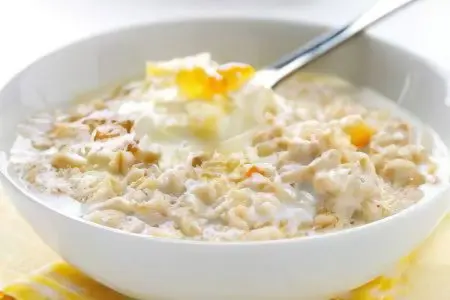
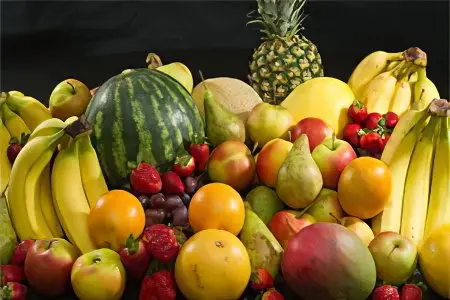
As sweeteners, beet or cane sugar, jam, jams from strawberries and sweet varieties of apples are used to a limited extent.
What can not be eaten with gastritis with high acidity?

With this type of inflammation, dishes containing the following substances are not recommended:
Stimulating the production of gastric juice;
Aggressively affecting the walls of the stomach;
Enhancing fermentation processes;
Poorly digested in the stomach.
Products that stimulate the production of gastric juice:
Kiwi. This sweet and sour exotic fruit, which tastes good, contains many vitamins, sugars and organic acids, as well as substances that stimulate tissue regeneration and have a local calming effect. Meanwhile, you should refrain from eating kiwi with hyperacid gastritis, especially in the acute stage. The ban is due to the possible negative effect of acids on the inflamed wall of the stomach;
Orange. All citrus fruits (lemon, lime, grapefruit, tangerine) stimulate taste buds and indirectly cause the production of hydrochloric acid. There are numerous scientific observations confirming the fact that a person produces saliva even just at the sight of a lemon. Therefore, with hyperacid gastritis, the use of any citrus fruits is strictly prohibited;
Garlic. The plant is known for phytoncides – substances that prevent the development of colds and are natural antibiotics. However, when consumed internally, garlic stimulates appetite, thereby causing an active production of gastric juice.
Products that aggressively affect the mucous membranes of the stomach:
Chocolate. Despite the abundance of useful substances, it is forbidden to use it for gastritis. The ban is associated with a high (about 40%) caffeine content in chocolate. Caffeine is known for its aggressive effect on the gastric sphincter and its ability to provoke reflux. Caffeine also has an irritating effect on the walls of the stomach. All these properties of caffeine and chocolate are undesirable for gastritis.
Ice cream. A delicious dairy product, however containing thickeners, flavors, preservatives, flavorings and colors. This cold sweet treat negatively affects the walls of the stomach;
Nuts it is undesirable to use with gastritis in large quantities (more than 30 grams per day);
Cashew nuts. This product contains a caustic oily substance from which natural ink is made, therefore cashews can cause gastritis aggravation;
Almonds and other stone nuts from fruits and berries (apricots, plums, cherries) contain a small amount of hydrocyanic acid, which has a bad effect on the walls of an inflamed stomach;
Hazelnut (hazel) – a product rich in nutrients, protein value is close to meat. However, hazelnuts contain small amounts of aggressive acids that adversely affect the intestines. For the stomach of a healthy person, their action is imperceptible, but with an inflamed mucosa, hazelnuts can enhance pathogenesis.
Products that enhance fermentation processes in the body:
Cereals (millet, corn, barley, beans). Porridges prepared from these cultures contain coarse fibers, increase the acidity of gastric juice and stimulate fermentation processes;
Peanut. This is not a nut, but the fruit of a leguminous plant. Like all legumes, peanuts cause fermentation in the stomach, thereby irritating its walls;
Grape. Contains a large amount of nutrients, while it has a lot of sugar. Grapes also have a thick skin, the components of which stimulate fermentation processes.
Foods that are poorly digested in the stomach:
meat-containing Products, poorly digested in the stomach, have a common feature – a high content of cholesterol and animal fats;
Low-fat pork, although it is on the list of products acceptable for dietary nutrition, it is not used in medical institutions. Therefore, we classified this type of meat as forbidden for gastritis;
Duck and goose meat, smoked meat products. Fats, found in excess in these meats and delicacies, inhibit the production of hydrochloric acid, resulting in a slower digestion. Fatty foods do not linger in the intestines, are quickly excreted from the body and often cause diarrhea;
Fat. The main energy value of this product is represented by animal fat. Salo contains a lot of salt and spices. Just like fatty meat, lard suppresses the production of hydrochloric acid, irritates the walls of the stomach and provokes diarrhea;
Canned meat and fish. Contain flavors, a lot of fat and other components that are poorly digested in a sick stomach;
Pelmeni. They are hard to digest, contain two components opposite in composition – boiled dough and minced meat. In conditions of gastritis with high acidity, the use of dumplings is accompanied by heartburn and heaviness in the stomach;
Liver. This product contains a huge (more than 270 mg per average serving) amount of cholesterol, in addition, the liver is the biological filter of the body, it accumulates and processes harmful substances that have entered the blood of an animal or bird. Despite the high content of vitamin A and other fat-soluble vitamins, the liver is not recommended for inflamed processes in the walls of the stomach.
Vegetable products that are poorly digested in the stomach include melons and watermelons.
Menu for the week
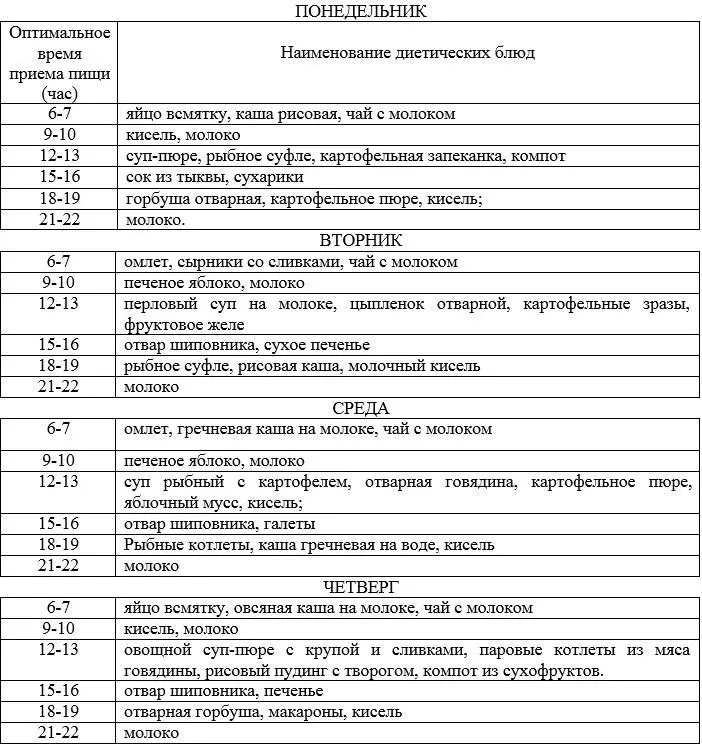
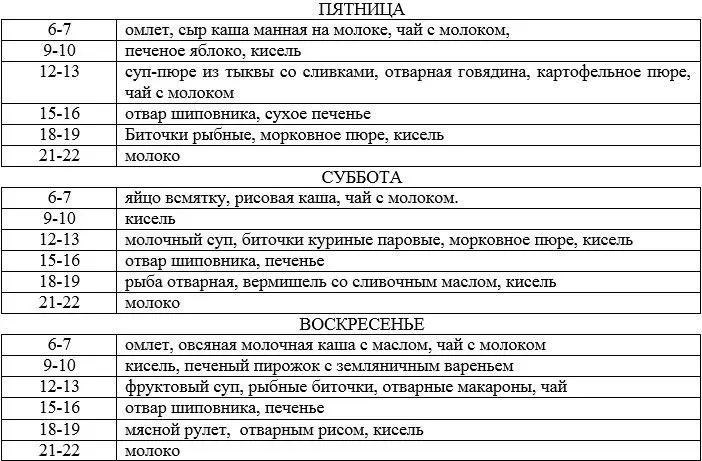
Diet for gastritis with low acidity
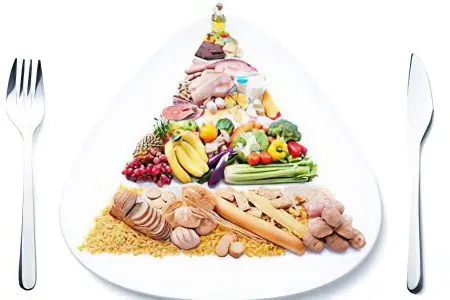
Hypoacid gastritis is manifested by belching, dyspepsia (usually diarrhea) and nausea. Symptoms are the result of insufficient digestion of food in the stomach. The recommended diet for low acidity has an official designation – No. 2.
With gastritis with a low level of digestive enzymes, food is enriched with foods that stimulate the production of hydrochloric acid.
Dietary nutrition of patients who have reduced production of hydrochloric acid is organized in the same way as a standard diet for gastritis. The set of products is approximately the same, but there are slight differences, since low acidity is due to insufficient production of digestive enzymes.
Unlike gastritis with high acidity, in this case you can:
Prepare dishes from rich meat and fish broths;
Eat sweet and sour fruits and berries, including citrus fruits;
There are pickles and tomatoes in reasonable quantities;
Instead of milk, drink fermented milk drinks (koumiss, kefir, fermented baked milk);
Drink fruit juices with a sour taste;
Drink mineral water without gas.
To improve the efficiency of digestion, food should be chewed thoroughly. Of the medications, the intake of digestive enzymes (Festal, Mezim-forte) is effective.
Diet for exacerbation of gastritis
Exacerbation of inflammation of the stomach is characterized by vivid symptoms – this is severe pain, diarrhea, constipation, vomiting, gastric bleeding. With an exacerbation of gastritis, dehydration is possible – weakness, pallor of the skin and mucous membranes, thickening of the liquid fraction of the blood.
In the first days of exacerbation, complete starvation and abundant drinking in the form of physiological solutions and liquids are allowed, which relieve inflammation and irritation of the walls of the stomach. From the second or third day, the gradual introduction of nutrients into the diet begins.
Subtypes of basic nutrition – diets 1a (for diarrhea) and 1b (for constipation) – are energy poor. In the diet, the amount of carbohydrates, proteins and fats is reduced. At the first stage of therapeutic nutrition, products that even slightly excite secretory function are completely excluded.
The diet menu for exacerbation of gastritis includes:
Mucous mucilaginous soups-puree on water with a gradual inclusion of milk;
Shredded lean meat (chicken, rabbit, tender veal, boneless fish) in the form of soufflé and steam cutlets;
Soft-boiled eggs, omelettes;
Porridges on water from crushed buckwheat, oatmeal, rice groats;
Drinks – berry jelly, weakly brewed tea without sugar.
After removing the symptoms of exacerbation, they gradually return to basic diets with increased or decreased acidity.
[Video] Dr. Berg is THE BEST VEGETABLE FOR GASTRITIS:









